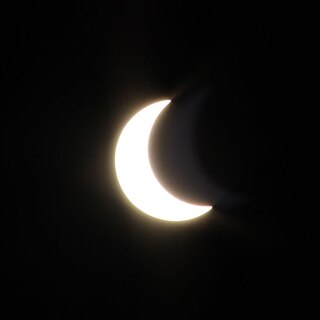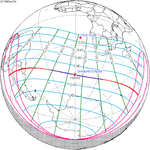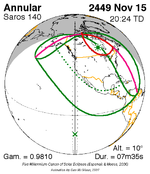Solar eclipse of February 26, 2017
| Solar eclipse of February 26, 2017 | |
|---|---|
 Partial from Buenos Aires, Argentina | |
| Type of eclipse | |
| Nature | Annular |
| Gamma | −0.4578 |
| Magnitude | 0.9922 |
| Maximum eclipse | |
| Duration | 44 s (0 min 44 s) |
| Coordinates | 34°42′S 31°12′W / 34.7°S 31.2°W |
| Max. width of band | 31 km (19 mi) |
| Times (UTC) | |
| Greatest eclipse | 14:54:33 |
| References | |
| Saros | 140 (29 of 71) |
| Catalog # (SE5000) | 9545 |
An annular solar eclipse took place on February 26, 2017. A solar eclipse occurs when the Moon passes between Earth and the Sun, thereby totally or partly obscuring the image of the Sun for a viewer on Earth. An annular solar eclipse occurs when the Moon's apparent diameter is smaller than the Sun's, blocking most of the Sun's light and causing the Sun to look like an annulus (ring). An annular eclipse appears as a partial eclipse over a region of the Earth thousands of kilometres wide. Occurring only 4.7 days before perigee (Perigee on March 3, 2017), the Moon's apparent diameter was larger. The moon's apparent diameter was just over 0.7% smaller than the Sun's.
It was visible across southern South America in the morning and ended in south-western Africa at sunset. In Argentina, the best places to see the eclipse were located in the south of the Chubut Province, in the towns of Facundo, Sarmiento and Camarones. Lunar Perigee occurred at about 2017 Mar 03 at 07:41:24.5 UTC, 4.7 days later.
Predictions and additional information
Eclipse characteristics
Eclipse Magnitude: 0.99223
Eclipse Obscuration: 0.98451
Gamma: -0.45780
Saros Series: 140th (29 of 71)
Conjunction times
Greatest Eclipse: 26 Feb 2017 14:53:24.5 UTC (14:54:32.8 TD)
Ecliptic Conjunction: 26 Feb 2017 14:58:23.4 UTC (14:59:31.7 TD)
Equatorial Conjunction: 26 Feb 2017 14:38:46.0 UTC (14:39:54.4 TD)
Geocentric coordinates of sun and moon
Sun right ascension: 22.66
Sun declination: -8.5
Sun diameter: 1938.0 arcseconds
Moon right ascension: 22.66
Moon declination: -8.9
Moon diameter: 1895.6 arcseconds
Geocentric libration of moon
Latitude: 5.1 degrees south
Longitude: 0.6 degrees east
Direction: 336.5 (NNW)
Images
Gallery
-
Partial from Villa Gesell, Argentina, 13:18 GMT
-
Coyhaique, Chile, 13:35 GMT, 1 minute before annularity
-
Partial from Pisco Elqui, Chile, 13:48 GMT
-
Partial from Punta del Este, Uruguay, 13:56 GMT
-
Partial from Puerto Cisnes, Chile, 14:17 GMT
-
Composed image as seen from Paraná, Argentina
-
Time lapse images as seen from Villa Gesell, Argentina
-
Animation of the eclipse as seen from Montevideo, Uruguay
Related eclipses
Eclipses of 2017
- A penumbral lunar eclipse on February 11.
- An annular solar eclipse on February 26.
- A partial lunar eclipse on August 7.
- A total solar eclipse on August 21.
Solar eclipses descending node 2015-2018
- Saros 120: Total Solar Eclipse March 20, 2015
- Saros 130: Total Solar Eclipse March 8–9, 2016
- Saros 140: Annular Solar Eclipse February 26, 2017
- Saros 150: Partial Solar Eclipse February 15, 2018
Tzolkinex
Preceded: Solar eclipse of January 15, 2010
Followed: Solar eclipse of April 8, 2024
Half-Saros cycle
Preceded: Lunar eclipse of February 21, 2008
Followed: Lunar eclipse of March 3, 2026
Tritos
Preceded: Solar eclipse of March 29, 2006
Followed: Solar eclipse of January 26, 2028
Solar Saros 140
Preceded: Solar eclipse of February 16, 1999
Followed: Solar eclipse of March 9, 2035
Inex
Preceded: Solar eclipse of March 18, 1988
Followed: Solar eclipse of February 5, 2046
Triad
Preceded: Solar eclipse of April 28, 1930
Followed: Solar eclipse of December 29, 2103
Solar eclipses 2015–2018
This eclipse is a member of a semester series. An eclipse in a semester series of solar eclipses repeats approximately every 177 days and 4 hours (a semester) at alternating nodes of the Moon's orbit.[1]
The partial solar eclipse on July 13, 2018 occurs in the next lunar year eclipse set.
| Solar eclipse series sets from 2015 to 2018 | ||||||
|---|---|---|---|---|---|---|
| Descending node | Ascending node | |||||
| Saros | Map | Gamma | Saros | Map | Gamma | |
120 Totality in Longyearbyen, Svalbard |
March 20, 2015 Total |
0.94536 | 125 Solar Dynamics Observatory |
September 13, 2015  Partial |
−1.10039 | |
130 Balikpapan, Indonesia |
March 9, 2016 Total |
0.26092 | 135 Annularity in L'Étang-Salé, Réunion |
September 1, 2016 Annular |
−0.33301 | |
140 Partial from Buenos Aires, Argentina |
February 26, 2017 Annular |
−0.45780 | 145 Totality in Madras, OR, USA |
August 21, 2017 Total |
0.43671 | |
150 Partial in Olivos, Buenos Aires, Argentina |
February 15, 2018 Partial |
−1.21163 | 155 Partial in Huittinen, Finland |
August 11, 2018 Partial |
1.14758 | |
Saros 140
It is a part of Saros cycle 140, repeating every 18 years, 11 days, containing 71 events. The series started with partial solar eclipse on April 16, 1512. It contains total eclipses from July 21, 1656 through November 9, 1836, hybrid eclipses from November 20, 1854 through December 23, 1908, and annular eclipses from January 3, 1927 through December 7, 2485. The series ends at member 71 as a partial eclipse on June 1, 2774. The longest duration of totality was 4 minutes, 10 seconds on August 12, 1692.
| Series members 23–53 occur between 1901 and 2450: | ||
|---|---|---|
| 23 | 24 | 25 |
 Dec 23, 1908 |
 Jan 3, 1927 |
 Jan 14, 1945 |
| 26 | 27 | 28 |
 Jan 25, 1963 |
 Feb 4, 1981 |
 Feb 16, 1999 |
| 29 | 30 | 31 |
 Feb 26, 2017 |
 Mar 9, 2035 |
 Mar 20, 2053 |
| 32 | 33 | 34 |
 Mar 31, 2071 |
 Apr 10, 2089 |
 Apr 23, 2107 |
| 35 | 36 | 37 |
 May 3, 2125 |
 May 14, 2143 |
 May 25, 2161 |
| 38 | 39 | 40 |
 Jun 5, 2179 |
 Jun 15, 2197 |
 Jun 28, 2215 |
| 41 | 42 | 43 |
 Jul 8, 2233 |
 Jul 19, 2251 |
 Jul 29, 2269 |
| 44 | 45 | 46 |
 Aug 10, 2287 |
 Aug 21, 2305 |
 Sep 1, 2323 |
| 47 | 48 | 49 |
 Sep 12, 2341 |
 Sep 23, 2359 |
 Oct 3, 2377 |
| 50 | 51 | 52 |
 Oct 14, 2395 |
 Oct 25, 2413 |
 Nov 5, 2431 |
| 53 | ||
 Nov 15, 2449 | ||
Inex series
This eclipse is a part of the long period inex cycle, repeating at alternating nodes, every 358 synodic months (≈ 10,571.95 days, or 29 years minus 20 days). Their appearance and longitude are irregular due to a lack of synchronization with the anomalistic month (period of perigee). However, groupings of 3 inex cycles (≈ 87 years minus 2 months) comes close (≈ 1,151.02 anomalistic months), so eclipses are similar in these groupings.
| Inex series members between 1901 and 2100: | ||
|---|---|---|
 May 18, 1901 (Saros 136) |
 April 28, 1930 (Saros 137) |
 April 8, 1959 (Saros 138) |
 March 18, 1988 (Saros 139) |
 February 26, 2017 (Saros 140) |
 February 5, 2046 (Saros 141) |
 January 16, 2075 (Saros 142) |
||
Metonic cycle
The metonic series repeats eclipses every 19 years (6939.69 days), lasting about 5 cycles. Eclipses occur in nearly the same calendar date. In addition, the octon subseries repeats 1/5 of that or every 3.8 years (1387.94 days). All eclipses in this table occur at the Moon's descending node.
| 21 eclipse events between July 22, 1971 and July 22, 2047 | ||||
|---|---|---|---|---|
| July 22 | May 9–11 | February 26–27 | December 14–15 | October 2–3 |
| 116 | 118 | 120 | 122 | 124 |
 July 22, 1971 |
 May 11, 1975 |
 February 26, 1979 |
 December 15, 1982 |
 October 3, 1986 |
| 126 | 128 | 130 | 132 | 134 |
 July 22, 1990 |
 May 10, 1994 |
 February 26, 1998 |
 December 14, 2001 |
 October 3, 2005 |
| 136 | 138 | 140 | 142 | 144 |
 July 22, 2009 |
 May 10, 2013 |
 February 26, 2017 |
 December 14, 2020 |
 October 2, 2024 |
| 146 | 148 | 150 | 152 | 154 |
 July 22, 2028 |
 May 9, 2032 |
 February 27, 2036 |
 December 15, 2039 |
 October 3, 2043 |
| 156 | ||||
 July 22, 2047 | ||||
Notes and references
- ^ van Gent, R.H. "Solar- and Lunar-Eclipse Predictions from Antiquity to the Present". A Catalogue of Eclipse Cycles. Utrecht University. Retrieved 6 October 2018.
References
- www.solar-eclipse.de - The annular solar eclipse of 02/26/2017
- NASA graphics
- hermet.org: Annular Solar Eclipse: February 26 2017
External links
- www.solar-eclipse.de - Average cloud coverage and cities along the eclipse path













